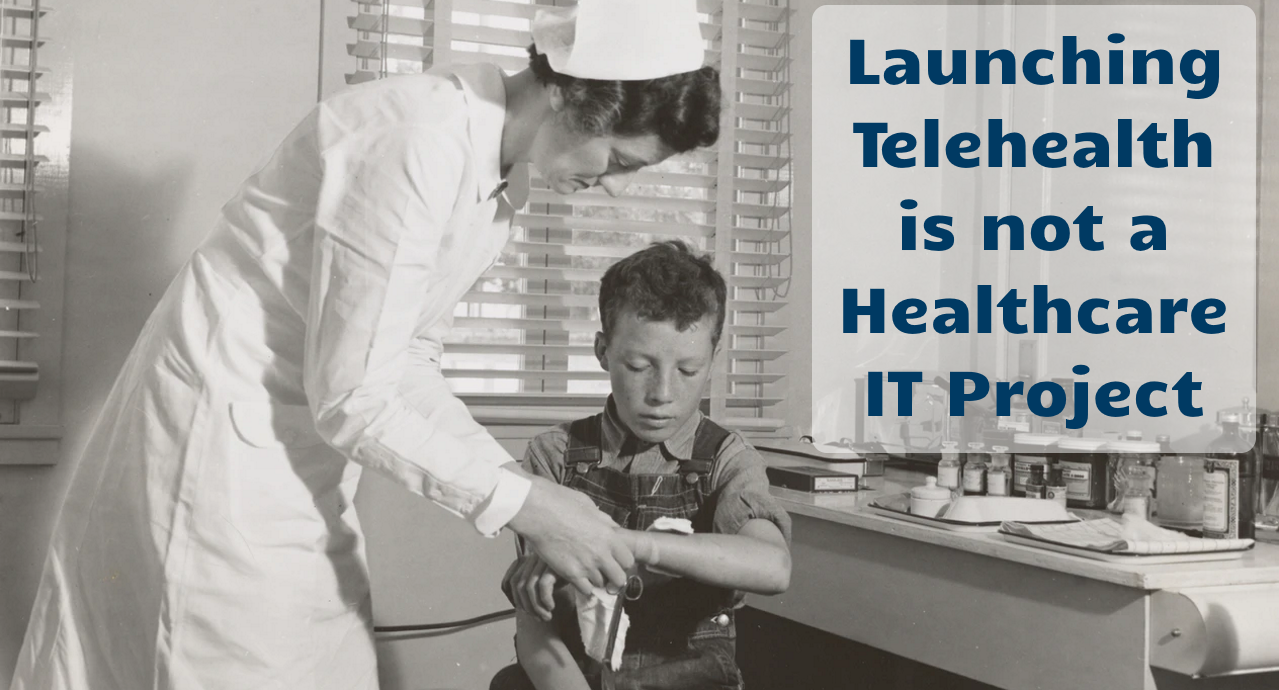Myths and legends are often born out of a misunderstanding of the complete picture. Similar to the fable of the elephant and the six blind men, when people only see a portion of the whole picture (or, as in the example of the blind men, have no reference point as to what an elephant is) their view becomes the truth.
In last week’s article I provided an overview of six common misconceptions about telehealth:
- Telehealth is a Health IT Acquisition and Deployment Project
- There is one technology solution for telehealth that everyone will use.
- Our IT staff is best suited to run our telehealth program.
- Telehealth Vendors will help us to properly set up our telemedicine services.
- Once we’ve established one telehealth service, we can quickly roll it out to others.
- Telehealth is just a different way to deliver care.
In the upcoming weeks I will address each misconception, by providing a more complete description of the reality and how this new understanding can help you in launching and managing telehealth services.
Misconception #1: Telehealth is a Health IT Acquisition and Deployment Project
Reality: Telehealth is the design, development and launch of new clinical service offerings.(that includes the acquisition and deployment of technology)
Over the past decades, the majority of health IT projects have mostly been about finding the best vendor and then deploying the solution, including the training of the users. Oftentimes, solutions were limited to single clinical department (e.g., a radiology image management system), or occasionally they’d affect all clinical areas (e.g., in the case of an EHR implementation). In most cases, the technology sat “on top” or “in between” the existing workflows.
By comparison, the launch of a new telehealth service offering is more akin to the launch of a completely new clinical service line, with all the complexities and activities that such an endeavor requires.
The reasoning about this misconception seems to go something like this: “We already know how to deliver care and in order for us to that remotely, virtually, or at a distance (pick your favorite term), we simply need some (video) technology to connect the patients with our clinicians.”
Telehealth, when understood as a new clinical service offering, however, is more complex than just the technology to conduct the visit. Due to the separation of the patient and provider in two different physical locations and since payors treat telehealth differently than a regular in-person visit, the effort involved in launching a new telehealth service is much more similar to launching a new clinical service offering than a simple technology installation.
As with any new clinical service offering (i.e., a new business line), you have to first verify that the new service is (1) strategically important, (2) has an underlying economically viable business case, and is (3) clinically proven. I.e., you wouldn’t want to invest time, money and staff on an initiative that does not advance the most important strategic goals, is not financially sustainable and may not even clinically be good medicine.
Once the viability of the new service offering has been established, the team needs to define the various workflows that together comprise the service offering – from determining patient eligibility for telehealth and scheduling appointments to ensuring proper documentation in the EMR and the policies and procedures for billing. Typically there are at least half a dozen workflows that need to be defined. It is those workflows that create the requirements of what the telehealth technology needs to accomplish. Ideally the technology is selected after the workflows have been defined and the technology requirements been identified.



Prior to the implementation across multiple clinicians and patient locations, it is my best practice in my work with healthcare organizations to launch telehealth first as a proof-of-concept to validate all assumptions and to optimize the various workflows, policies and technology configuration.
Only after the various workflows have been tested and optimized and after the lessons learned about the technology have been documented is it time to deploy the workflows and technology across a broader set of providers and locations.
Thus, the launch of a new telehealth service is much more than simply the acquisition and deployment of a technology solution.
Next week, I’ll cover the 2nd common misconception: That there is a single technology solution that everyone will use for telehealth.








To receive articles like these in your Inbox every week, you can subscribe to Christian’s Telehealth Tuesday Newsletter.
Christian Milaster and his team optimize Telehealth Services for health systems and physician practices. Christian is the Founder and President of Ingenium Digital Health Advisors where he and his expert consortium partner with healthcare leaders to enable the delivery of extraordinary care.
Contact Christian by phone or text at 657-464-3648, via email, or video chat.







Leave A Comment